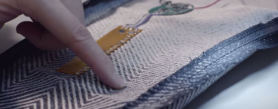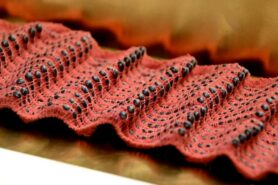Fashion of the Future
Smart Fashion: Will a Scientist be the Next Coco Chanel?
Did you ever imagine going to work in a shirt that can do everything a computer does and connect to Wifi? If not, then you haven’t heard about ‘Smart Fashion’. Scientists and engineers are now moving out of the laboratory and into the fashion atelier. They are reimagining the medical and technological functions behind the items that touch our skin everyday–our clothes. ‘Smart clothes’ are promised to be the next revolutionary products that will change our lives. But will these revolutionary fashion items actually be designed by scientists rather than fashion designers?
What are Smart Clothes?
Today’s fashion developments are not only for the pages of ‘Vogue’. Wearable sensors are the new technological hype. Science and technology journals and magazines such as Nature, IDTechEx and TechTales all feature wearable-sensor news alongside other developments in the fields of AI and sustainable technology, and predict that ‘smart clothes’ would be sold commercially by 2030.

Denim looking E-textile
Put simply, ‘smart clothes’ are wearable computing devices that track information from the wearer and can transmit that information wirelessly. Advancements in nano (small-scale) science and technology are transforming the touch-sensitive materials of smartphones and hospital devices into tiny fibers or sheets that are highly flexible and water-resistant. These materials are then integrated with regular textiles to create fabrics called E-textiles. So what may look like a regular denim fabric may actually be a flexible computer that tracks and interacts with the data it receives from our skin.

Flexible Skin Sensor
Wearable sensor experts consider human skin, our largest organ, to be the ultimate sensor; the skin senses and reflects what is happening on the inside of the body through changes in temperature and chemistry. E-textiles use advanced digital and biochemical technology to mimic our skin: they can pulsate, contract and expand, or act as a filter that can transfer or block certain chemicals for example. And by being in constant contact with our skin, E-textiles can also sense our temperature, heart rate, respiratory function and sweat, analyze changes, transmit that information to external sources and act in response.
Fashion and Science and Revolutionary Ideas

NadiX Yoga Pants
E-textiles creators are reimagining the functions behind our everyday clothes in a comfortable and non-invasive way. These days, shirts, pants, sports bras and socks are designed for personal or medical use and can send live updates to our smartphones or doctors. TechTales already reported how experimental E-textiles can detect harmful bacteria, antibiotics, and insulin levels through our skin and release medication directly into it accordingly. E-textiles are also combined in the design of sportswear to encourage healthier lifestyles, such as NadiX yoga pants, pulsating yoga pants that sense your posture and signal you to correct or hold on to that pose a while longer, or bathing suits that let you know when you have been sitting long enough in the sun.
But the creators of ‘smart clothes’ would not be the first to revolutionize society through fashion. Back in the 1920s, Coco Chanel shocked the world by making dresses out of jersey cotton (normally used for dock-worker shirts) instead of silk. Scientists and engineers, who aim to improve lives through wearable technology, are merely following in the footsteps of designers such as Chanel.
Maya Arazi, senior lecturer and expert on ‘wearable technology’ at Shenkar College for Engineering and Design in Israel, commented that like scientists, designers are trained to think about the future, solve everyday problems and rethink traditional products and materials. She commented that fashion has always acted like a second skin that senses our environment, and said that “fashion is a type of sensor in and of itself; it senses and reflects what is happening in society back to us.” Just think about Covid-19 and how facemasks are now appearing in fashion shows and shops.

bbc.com report from Paris Fashion Week
Arazi leads courses such as ‘fashion and technology’ and ‘design for engineers’ for design and engineering students and thinks that scientists and engineers have a lot to learn from designers in the development of E-textiles and in general. “I see that scientifically trained students have a very logical and linear way of solving problems. They envision their solution already in the research stage. But new solutions cannot be imagined before an organic research process. that draws on unexpected inspiration, takes place. Designers know that the end product may be completely different from what they first imagined.” Design thinking, therefore, leads to unexpected innovation.
The Future of Fashion Design
Arazi thinks that scientists alone will not be able to replace the fashion designers, but concedes that future fashion designers will have to be well versed in science and technology “if they want to be at the cutting edge of fashion and create influential changes.” But Arazi concluded by saying that the true future of ‘smart clothing’ lies in the formation of interdisciplinary teams that include scientists, engineers and designers: “there are no modern Leonardo da Vincies these days; revolutionary ideas and discoveries are a product of multidisciplinary teamwork.”
Such multidisciplinary teams are already being developed in special labs at educational institutions. Part science lab, part designer studio, these labs bring together scientists, designers, and engineers to rethink the future of products and architecture. Some examples are the American MIT, working on different types of E-textiles, or the Dutch TU Delft, which explores the possibilities behind sustainable textiles made out of living microorganisms, such as fungi.

The new fiber developed by researchers at MIT and in Sweden called OmniFibers. https://www.media.mit.edu/projects/omnifiber-millifluidic-muscle-fibers/overview/
The MIT Media Labs recently announced, for example, that a collaboration between one of their teams with a Swedish team has successfully developed a new textile that aids singers, athletes, and people recovering from respiratory diseases. The textile, named OmniFiber, is based on robotics technology and made out of layers of touch-sensitive fibers that sense the wearer’s breath and mimic the muscle activity around their lungs based on their needs by contracting and expanding. This textile has a central channel through which fluids such as water or air can pass, like the blood system in our body. When activated, it creates a contracting or expanding sensation. Wearing this textile as a shirt helps regulate a person’s breathing by providing pressure around the chest area or by vibrating to assist in breathing.
Following these examples, and listening to Arazi, it seems that future fashion will not be a result of an individual scientist, but rather a product of a collaborative effort of several individuals and institutions. It is clear that future innovators need to go beyond one’s own comfort zone, open up to different techniques, and learn the creative language of other disciplines. While it may still take some years before we will be wearing ‘smart clothes’, it appears that a cleaner and healthier future can be the product of unexpected teamwork.

